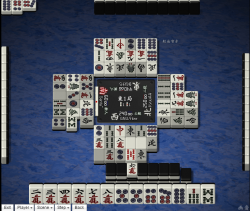Haitei raoyue and houtei raoyui
| Type | Yaku |
|---|---|
| Kanji |
海底撈月 河底撈魚 |
| English |
Win by last draw Win by last discard |
| Value | 1 han |
| Speed | Very Slow |
| Difficulty | Luck |
Haitei raoyue (海底撈月) or simply Haitei is a standard yaku, where a player wins with the tsumo on haiteihai, the last drawable tile from the live wall. As such, this yaku is only accessible via tsumo.
Houtei raoyui (河底撈魚) is the ron variant to haitei, depends on the last discarded tile of a hand. This yaku is awarded to a player calling ron while the live wall is empty.
The last tile draw and discard is defined by the dead wall. By rule, the dead wall must retain 14-tiles at all times; and this includes any revealed dora indicators. Naturally, to score either haitei or houtei, a player must be at tenpai at the end of the hand just before ryuukyoku.
Compatability
| RCH | DRI | IPP | SMO | TAN | PFU | IPK | ITT | YAK | SDJ | SDO | TOI | SNA | SNK | CHA | JUN | RPK | SSG | HRO | HON | CHN | CHI | RIN | HAI | HOU | CHK | |
| HAI | ||||||||||||||||||||||||||
| HOU |
Both yaku cannot be combined in a single hand, as it is impossible to win by draw and by discard at the same time.
With rinshan kaihou
Neither yaku cannot be combined with rinshan kaihou, which requires an extra tile draw from from dead wall after a kan.
When winning on the replacement tile after a kan, haitei is applied to a live wall draw but not on a tile from the dead wall. With regards to houtei, the last discarded tile cannot be called to complete melds or be used to form daiminkan (open kans).
Furthermore, per rule, the dead wall must be maintained at 14 tiles. A kan call at the very last tile draw or discard would deny the replenishment of a tile from the regular wall to the dead wall. In other words, forming a kantsu with the very last tile or discard, followed by drawing the rinshanpai, would deplete the dead wall to 13 tiles.
A potential scenario may arise when the second to last tile draw or discard may be legally used to call kan. In turn, that would leave the very last tile from the regular wall to be shifted into the dead wall as the replacement tile. If rinshan kaihou does occur, the rinshanpai could be viewed as the last draw. However, the last draw must come from the regular wall in order to count as haitei. If a tile is discarded instead of calling tsumo win here, that will be the last discard of the game. This last discard may suffice for houtei, to another player, of course.
Setting up haitei raoyue or houtei raoyui

Like any hand, either yaku requires tenpai at the very last draw and/or discard to even have a chance of winning.
External links
- Haitei raoyue in Japanese Wikipedia.
- Houtei raoyui in Japanese Wikipedia.
| |||||||||||||||||||||||||||||||
